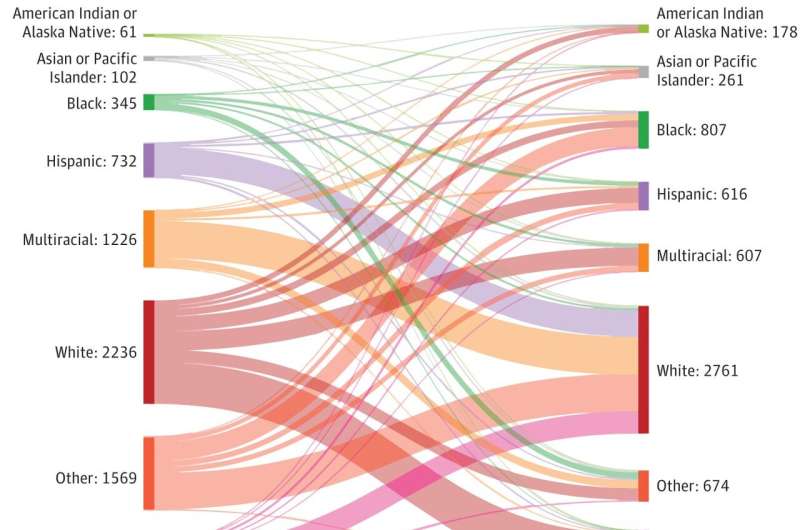This article has been reviewed according to Science X's editorial process and policies. Editors have highlighted the following attributes while ensuring the content's credibility:
fact-checked
peer-reviewed publication
trusted source
proofread
Same ER. Same patient. Different visit: Study shows variation in data used to address health care disparities

For decades, the national effort to find and fight inequity in American health care has relied on vast amounts of anonymous medical record data from tens of millions of people.
And since many of those inequities are between groups of people from different racial and ethnic backgrounds, data on these characteristics is especially important to collect accurately and consistently when patients get care.
But a new study shows this doesn't always happen.
In all, 1.7% of adults and 7% of children who sought emergency care at least twice at the same Michigan hospital or health system had a different race or ethnicity marked in their patient records on different visits.
Nearly 26% of adult patients who were registered as being Black and of non-Hispanic origin at their first visit, and 39% of those who were registered as being part of a catch-all category of Other race and ethnicity at their first visit, had a different race or ethnicity recorded at their second emergency visit to the same hospital or health system.
Among children, those recorded as being white, multiracial, or other on their first visit had another race or ethnicity recorded during their second emergency visit, with 32%, 18%, and 23% experiencing this difference, respectively.
The findings suggest that hospitals and health systems need to do more to standardize practices for collecting race and ethnicity data in their emergency departments. What gets marked in a patient's record in the ED might not get reexamined as they receive care during a hospitalization or at post-emergency visits. In some cases, the ED visit may be the only kind of care disadvantaged people receive.
The study looked at data from more than half a million people who had two or more emergency visits at 42 hospitals from late 2018 to late 2021. It's published in JAMA Network Open by a team from Harvard University, the University of Michigan, and Northwestern University, and based on data from a registry maintained by the Michigan Emergency Department Improvement Collaborative or MEDIC.
Keith Kocher, M.D., M.P.H., who leads MEDIC and is senior author of the new study, says it suggests that "the current race and ethnicity data in electronic health record systems has important limitations, especially when influencing administrative decisions, clinical processes, research, or for countless other purposes."
Kocher, an emergency medicine physician and researcher at Michigan Medicine and the University of Michigan Institute for Healthcare Policy and Innovation, worked with first author Rama Salhi, M.D., M.H.S., M.Sc., who trained at IHPI's National Clinician Scholars Program before moving to Harvard and Massachusetts General Hospital.
In an accompanying editorial, a team of experts on health care disparities research note that "high-quality data are needed to appropriately measure and address pervasive racial and ethnic health disparities with data-driven policies that advance health equity."
More information: Rama A. Salhi et al, Frequency of Discordant Documentation of Patient Race and Ethnicity, JAMA Network Open (2024). DOI: 10.1001/jamanetworkopen.2024.0549
Lahia Yemane et al, Race and Ethnicity Data in Electronic Health Records—Striving for Clarity, JAMA Network Open (2024). DOI: 10.1001/jamanetworkopen.2024.0522





















